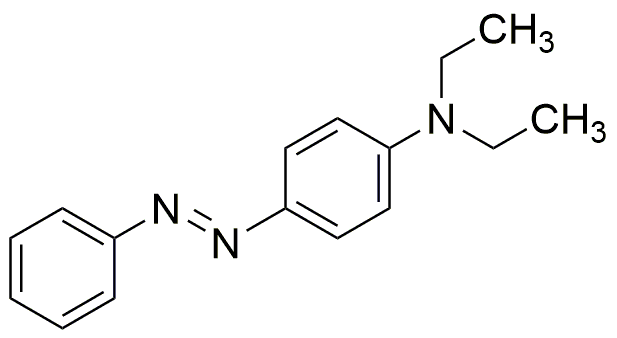4-(Diethylamino)azobenzene is widely utilized in research focused on:
- Dyes and Pigments: This compound is a key ingredient in the production of vibrant dyes used in textiles and inks, providing excellent color stability and brightness.
- Photochemical Applications: It serves as a photosensitive material in photolithography, crucial for the manufacturing of electronic components and microchips.
- Biological Research: The compound is employed in studies involving cellular imaging and tracking, helping researchers visualize and understand cellular processes.
- Analytical Chemistry: It is used as a reagent in various analytical techniques, aiding in the detection and quantification of other substances in complex mixtures.
- Polymer Chemistry: This chemical is applied in the development of photoresponsive polymers, which can change properties when exposed to light, useful in smart materials and coatings.
Informations générales
Propriétés
Sécurité et réglementation
Applications
4-(Diethylamino)azobenzene is widely utilized in research focused on:
- Dyes and Pigments: This compound is a key ingredient in the production of vibrant dyes used in textiles and inks, providing excellent color stability and brightness.
- Photochemical Applications: It serves as a photosensitive material in photolithography, crucial for the manufacturing of electronic components and microchips.
- Biological Research: The compound is employed in studies involving cellular imaging and tracking, helping researchers visualize and understand cellular processes.
- Analytical Chemistry: It is used as a reagent in various analytical techniques, aiding in the detection and quantification of other substances in complex mixtures.
- Polymer Chemistry: This chemical is applied in the development of photoresponsive polymers, which can change properties when exposed to light, useful in smart materials and coatings.
Documents
Fiches de données de sécurité (FDS)
La FDS fournit des informations de sécurité complètes sur la manipulation, le stockage et l’élimination du produit.
Spécifications du produit (PS)
Le PS fournit une description complète des propriétés du produit, notamment sa composition chimique, son état physique, sa pureté et les exigences de stockage. Il détaille également les plages de qualité acceptables et les applications prévues du produit.
Certificats d'analyse (COA)
Recherchez des certificats d'analyse (COA) en saisissant le numéro de lot du produit. Les numéros de lot et de lot se trouvent sur l'étiquette d'un produit, après les mots « Lot » ou « Lot de fabrication ».
Numéro de catalogue
Numéro de lot/série
Certificats d'origine (COO)
Ce certificat d'exploitation confirme le pays dans lequel le produit a été fabriqué, et détaille également les matériaux et composants utilisés et s'il est issu de sources naturelles, synthétiques ou autres sources spécifiques. Ce certificat peut être requis pour les douanes, le commerce et la conformité réglementaire.
Numéro de catalogue
Numéro de lot/série
Fiches de données de sécurité (FDS)
La FDS fournit des informations de sécurité complètes sur la manipulation, le stockage et l’élimination du produit.
DownloadSpécifications du produit (PS)
Le PS fournit une description complète des propriétés du produit, notamment sa composition chimique, son état physique, sa pureté et les exigences de stockage. Il détaille également les plages de qualité acceptables et les applications prévues du produit.
DownloadCertificats d'analyse (COA)
Recherchez des certificats d'analyse (COA) en saisissant le numéro de lot du produit. Les numéros de lot et de lot se trouvent sur l'étiquette d'un produit, après les mots « Lot » ou « Lot de fabrication ».
Numéro de catalogue
Numéro de lot/série
Certificats d'origine (COO)
Ce certificat d'exploitation confirme le pays dans lequel le produit a été fabriqué, et détaille également les matériaux et composants utilisés et s'il est issu de sources naturelles, synthétiques ou autres sources spécifiques. Ce certificat peut être requis pour les douanes, le commerce et la conformité réglementaire.


